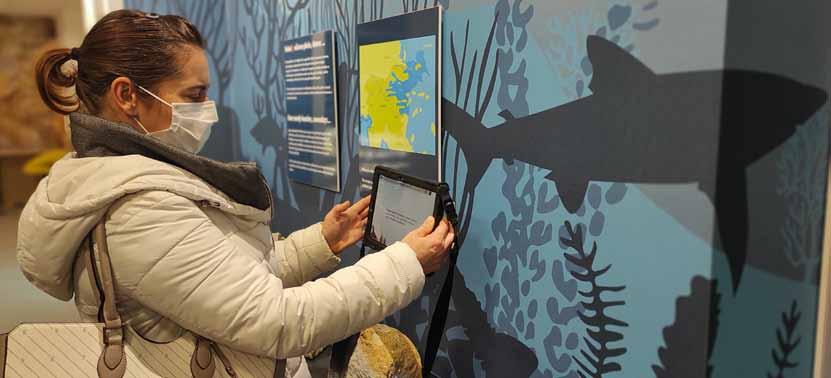
4 minute read
Tourist pressure at the Iron-Age site is managed
project partners visited several small but interesting and immersive museum centres with different technical solutions in Štajerska region. photo: J. Kusetič
The topics of the Mobility Actions were: • Knowledge transfer and collaboration between key institutions in the region, • The use of modern didactic approaches, • Digital tools and equipment in state-of-the-art presentations, • An overview of cultural routes and digitization of cultural heritage and their role in (sustainable) tourism, • The characteristics of the Danube Iron Age Cultural Route. • Excursions – examples of the use of digital technology in cultural heritage.
Advertisement
The event was organized across five consecutive days, between November 8th and 11th 2021, at the premises of the National Museum of Slovenia, Park of Military History Pivka, Prem Castle, Botanic Garden of University of Maribor Pivola and the Regional Tourist Centre Septarija. A total of 158 participants were present at Mobility Action events (all five days, both in person and online), consisting of representatives from different target groups: 10 from higher education and research, four from SMEs, four from local public authorities, 18 from a national public authority and 122 from the general public. The events were organized in a hybrid way – in addition to in-person events, the content was also livestreamed via Zoom, YouTube and Facebook. In this way the topics of the Mobility Actions were strongly linked to the European Commission’s recommendations concerning the digitisation and online accessibility of cultural material and digital preservation (C(2011) 7579 final) and the Digital Agenda for Europe by encouraging “partnerships between cultural institutions and the private sector in order to create new ways of funding digitisation of cultural material and to stimulate innovative uses of the material” and making “use of the EU’s Structural Funds, where possible, to cofinance digitisation activities in the framework of regional innovation strategies for smart specialization”.
SUMMARY ACTIVITIES
Day 1: Curators for Curators & VR experience
Target groups: Professional – project partners. Introductory day for curators and heritage managers, and presentation by the National Museum of Slovenia. The curators from other project partner institutions discussed the field of digital agendas and other relevant topics, like museology and archaeological landscape research. The main aim of the event was accomplished – increasing the knowledge transfer and collaboration between key institutions in the region. In the second part of the day, a curator team visited the VR exhibition in the Union Museum and experienced the current virtual tour on the topic of brewing. The day concluded with a discussion and dinner.
Day 2: Use of modern didactic approaches, digital tools and equipment in state-of-the-art presentations
Target groups: Professional – experts in the field of museology (curators, museum pedagogues), tourism, the IT sector, and the general public. Lectures were conducted that showcased the latest innovative approaches for the didactic use of digital technology, with the addition of the most common practical examples. Within the frame of the project, the strategies of digitization of archaeological heritage were presented. The basic hardware and software for digitization of heritage, and its associated limits, were also discussed. Jože Rugelj (Faculty of Education) – Effective learning with multimedia learning materials. Rugelj, PhD presented the theory of cognitive load within the learning process, and Mayer’s principles for their effective management using multimedia. Nataša Potočnik (experience designer at Enigmarium®, SME) - Using gamification to design unforgettable experiences to enliven cultural sites, museums and castles. Nataša Potočnik, who is also a president of the Slovene Association of Escape Room Activities, talked about a “thinking outside of the room” approach to bring local history back to life, and how to use gamification to design unforgettable and immersive experiences to breathe life back into enliven cities, cultural sites, museums and castles. She also presented some examples of the escape room contents, and how to bring cultural heritage themes to the public, to cities and landscapes. Nejc Dolinar (Institute for protection of Cultural Heritage of Slovenia) – Presentation of Strategies “Digitization of Archaeological Heritage for Sustainable Tourism”. Žiga Lesar (Faculty of Computer and Information Science) - Virtual tours (VR technical equipment and virtualization of space). The presentation was held on the topic of VR hardware and room virtualization, and the use of these technologies in archaeology and museology. The capture of spaces, digitization, reconstruction on the screen and, of course, the connection to VR. Sašo Knez (AFormX, SME) - Flights into history (how to build VR time-machine). AFormX is a company developing VR based flight simulators. They are the global leader in a niche market of historical VR flight simulators. This lecture presented the underlying principles involved in designing a successful educational VR experience. This lecture was a “recipe” on how to build a VR time-machine.
Day 3: Cultural routes and digitization of cultural heritage, and their role in (sustainable) tourism
Target groups: Professional – experts in the field of museology and tourism, other stakeholders, policy makers (e. g. Ministries), and the general public. Presentations of cultural routes and guided discussion on the topic. The guests at the round table discussions were also decision-makers (Ministry of Culture, Municipalities etc.) They presented their main strategies and documents for implementing digital technology in cultural heritage. A fruitful discussion ensued between decision-makers, museums, SMEs and the IT sector about digitization in cultural heritage. IADR Association - Iron Age Danube Route TALKS. Digital paths along the Iron Age Danube route. Integrated Approach in the Presentation of Archaeological Heritage. Round table discussions with SMEs, curators and IT sector about managing and making the paths sustainable using the digital technology.





